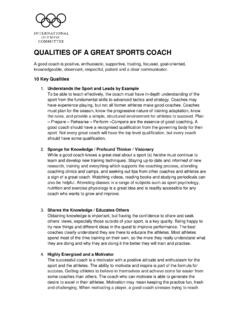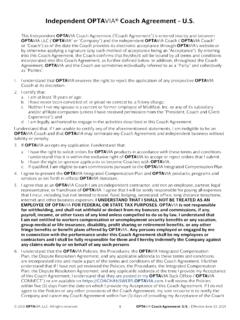Transcription of Lifestyle Coach Training Guide - Centers for Disease Control …
1 Lifestyle Coach Training Guide With Associated HandoutsInstructionsThis document contains materials to help Lifestyle coaches provide the PreventT2 Curriculum, including participant handouts. For participant materials, please see the Participant Training Guide . To quickly navigate to any specific session or handout, simply choose the appropriate selection from the table of contents. On the cover sheet of each session and handout, you'll find a "Home" button to quickly navigate back to the table of entire document can be printed using the printer icon in your toolbar, or you can print any individual session or handout by selecting the "Print Session" or "Print Handout" button at the beginning of each section.
2 Should you have any questions, please contact the National Diabetes Prevention Program Customer Service center at or submit your question at of Contents Sessions First 6 months of Program: -Program Overview-Introduction to the Program-Get Active to Prevent T2-Track Your Activity-Eat Well to Prevent T2-Track Your Food-Get More Active-Burn More Calories Than You Take In-Shop and Cook to Prevent T2-Manage Stress-Find Time for Fitness-Cope with Triggers-Keep Your Heart Healthy-Take Charge of Your Thoughts-Get Support-Eat Well Away From Home-Stay Motivated to Prevent T2 Last 6 months of Program.
3 -When Weight Loss Stalls-Take a Fitness Break-Stay Active to Prevent T2-Stay Active Away from Home-More About T2-More About Carbs-Have Healthy Food You Enjoy-Get Enough Sleep-Get Back on Track-Prevent T2 for Life!Handouts - Lifestyle Coach Log-Fitness Log-Food Log-Weight Log-Action Plan Journal-Program Meeting Schedule-Quick Guide -Ready, Set, Quit!-To Learn More-Certificate of CompletionLifestyle Coach Training Guide Program Overview Program Overview Acknowledgments The Centers for Disease Control and Prevention (CDC) Division of Diabetes Translation developed the Prevent T2 Lifestyle Change Program.
4 Prevent T2 is a yearlong Lifestyle change program for people at risk of developing type 2 diabetes. Prevent T2 was developed following a comprehensive review of over 25 years of scientific research on behavioral strategies that have been shown to be effective in preventing or delaying the onset of type 2 diabetes. Key authors of the Prevent T2 Lifestyle Coach Guides and corresponding Participant materials are: Centers for Disease Control and Prevention Stephanie Gruss, , Ann Albright , RD Elizabeth Luman, AFYA, Inc. Julia Wittner, Jann Keenan, Dana Conner, Terri Moore (Graphic Design) Michelle Bieber-Tregear, (Project Director) Lifestyle Coach Training Guide : Program Overview2 Diabetes Prevention Specialists and Other Contributing Experts Nangel Lindberg, ( center for Health Research, Kaiser Permanente Northwest) Jorge Ruiz, (University of Miami School of Medicine) Hermes Florez, , , (University of Miami School of Medicine) Sophia Hurley, (National center for Health Promotion and Disease Prevention, VA) Luis Falque-Madrid, (University of Zulia) Jerry A.
5 Schultz, (University of Kansas) Alexis Williams, , CHES (CDC) David Dennison, , CHES (CDC) Kristina Ernst, RN, CDE, BSN (CDC) Lifestyle Coach Training Guide : Program Overview3 Lifestyle Coach Training Guide : Program Overview Program focus The Prevent T2 Lifestyle Change Program is a yearlong program designed for people with prediabetes. It is also designed for people who are at high risk for type 2 diabetes and want to lower their risk. Program goals Prevent T2 helps participants achieve moderate weight loss by eating well and being active. By the end of the first six months, the goal is for participants to: Lose at least 5 to 7 percent of their starting weight Get at least 150 minutes of physical activity each week, at a moderate pace or moreBy the end of the second six months, the goal is for participants to.
6 Keep off the weight they have lost Keep working toward their goal weight, if they haven t reached it Lose more weight if they wish Keep getting at least 150 minutes of activity each weekProgram structure In order to achieve CDC recognition, your program must last for a full year and complete at least 22 modules. We suggest meeting: Once a week for four months (sessions 1 to 16) Every other week for two months (sessions 17 to 20) Once a month for six months (sessions 21 to 26)You can follow a different schedule, if you prefer. But you must complete at least 16 sessions in the first 6 months and another 6 sessions in the second six months.
7 44 Lifestyle Coach Training Guide : Program Overview Your role as a Lifestyle Coach Your role is to help participants set goals, track their eating and activity, assess their progress, and solve problems. Along the way, you need to collect data and write it in your Lifestyle Coach Log. Set the tone Foster a supportive and respectful group culture. Encourage participants to share their thoughts and feelings. But don t pressure them to do so. Make sure all participants get a chance to speak. Engage participants Avoid lecturing. Instead, use teaching strategies that engage participants.
8 Do the hands-on activities listed in the Lifestyle Coach Training Guides. When it s time to review a handout, ask for volunteers to read it to the group. Or ask them questions about it. Participants differ in their tastes, beliefs, and interests. Tailor the program to your particular group as much as you can. Keep an eye on the time Make sure to cover key content within the one-hour time frame. Keep a watch or clock handy. If a discussion is going on too long, table it for another time, such as after the session. To help you stay on track, the Lifestyle Coach Training Guides suggest how many minutes to spend on each section.
9 They also label some activities optional. Support participants Some participants may face personal barriers to Lifestyle change. For instance, a participant may have trouble reading and writing. They may be able to track their eating and activity in other ways, such as recording their voice or taking a photo. Suggest they ask a friend or family member to help them fill in forms. Or do it yourself. Another participant may have trouble reaching their fitness goal because of painful arthritis. Help them find ways they can be active, such as swimming, yoga, or Tai Chi. Other participants may face environmental barriers to Lifestyle change.
10 For instance, they may have limited access to healthy food, transportation, childcare, a safe place to walk, technology, time, and healthcare. Help participants work through these barriers. 55 Lifestyle Coach Training Guide : Program Overview Participants role At home, participants are required to: Track their minutes of activity each day (starting after the Track Your Activity Modeule) Write their minutes of activity in their Fitness Log During sessions, participants are required to: Bring their Participant Notebook Show you their Fitness Log (starting after the Track Your Activity module) Weigh in Write their weight in their Weight LogAt home, participants are encouraged to.














